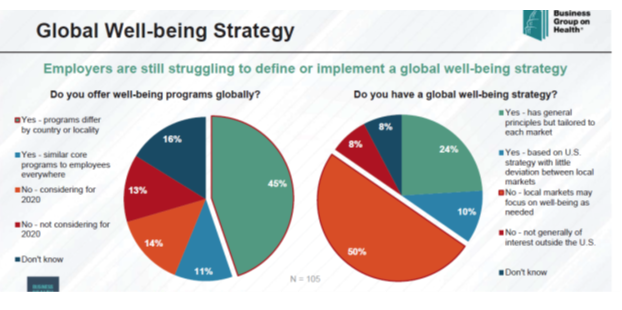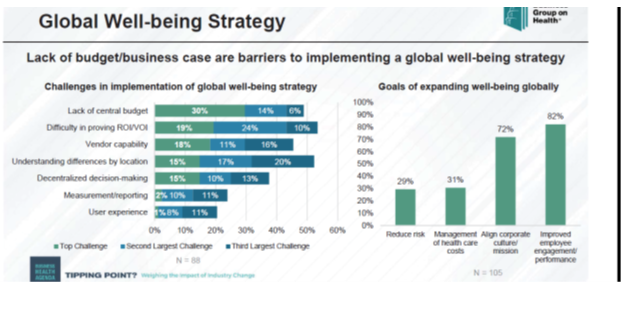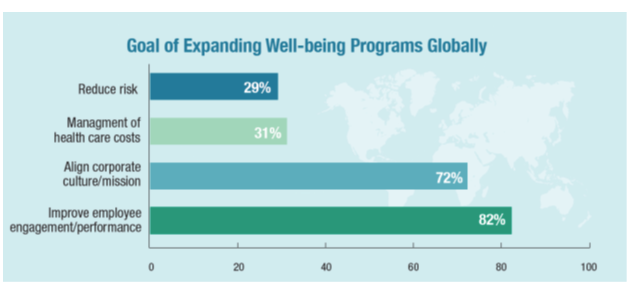January 09, 2020
A key component of a successful business is having a fully engaged global workforce. To maximize the potential and productivity of individuals, teams and businesses, companies must consider the rippling impact of poor employee health on the entire organization.
In order to accomplish this goal, many companies undertake strategic efforts to address the five pillars of well-being which, include physical health, emotional health, financial security, social connectedness and job satisfaction of employees around the world.



Physical Well-being
Employee engagement in physical activity remains a priority for a majority of Global Institute members. Many choose to address this challenge in various ways, through:
- WHO Communication Campaigns. Some companies communicate their health promotion and prevention efforts by tying them to global health observances.
- Company sponsored health benefit plans. Not all national health systems are equal. Many employers identify and fill gaps with supplemental programs. Plan design and minimum core coverage strategies are also pursued.
- Tobacco Cessation. Business Group on Health resources can help you get started, see our Global Tobacco-Free guide.
- Onsite fitness/subsidies. Promote engagement in physical activities.
- Nutrition Programs. Adopting a global healthy eating or nutrition policy, nutrition education, weight management programs, an working with local vendors to identify culturally appropriate programs.
Financial Well-being
An employees' financial situation is a source of stress and can be a drain on their work productivity. Many employers offer an array of solutions to help employees reduce finance-related stress that go beyond traditional retirement planning. They include:
- Financial seminars/lunch-n-learns
- One-on-one sessions with financial advisers or coaches
- Financial health challenges
- Student loan repayment benefits
- Retirement Plans – Reviewing existing pension/ savings benefit plans offered
Mental and Emotional Well-being
Given the data on the prevalence of mental health issues, this is a key pillar of well-being programs. A global Employee Assistance Program is often the foundation of any mental well-being program. Beyond EAP, many organizations focus their efforts around mental health stigma, resilience and mindfulness initiatives.
- Some companies have joined campaigns to address stigma—BP & JPMorgan Chase joined the U.K.’s This is Me Campaign¹
- Facebook launched a campaign, #Open up², that encourages employees to share their stories on resiliency and mental health.
- Other companies, especially those in the tech space and oil and gas industries, promote global resilience and mindfulness programs
Social Connectedness
Social connectedness encompasses supportive positive relationships and social belonging. Friendships among employees can promote positive business outcomes.
Several Global Institute members use physical health challenges such as step challenges and campaigns to engage and connect employees with one another and address specific well-being targets. Health challenges and mental health campaigns (such as those described on the previous slide) support not only an employee’s physical and mental well-being, but also their social well-being.
- Volunteering as team
- Office sponsored events and activities that give employees a sense of belonging
Job Satisfaction
Employers have an important stake in prioritizing employees’ satisfaction with their jobs, as the happiness of employees can translate into several important outcomes by adding to organizational citizenship and lowering employee turnover and absenteeism.
There are several factors that contribute to job satisfaction such as appropriate managerial feedback and ensuring an adequate work-life balance.
Employee Engagement
An organization’s well-being efforts rely entirely on the engagement of their workforce. Employers can promote employee engagement in their global well-being strategy by:
- Marketing programs within their global strategy to create employee awareness
- Leveraging local resources
- Encouraging variety in local health care programming
- Designing programs that incorporate continuous evaluation
- Allowing programs to grow incrementally over time
- Not being afraid to repeat your message, as it has been shown to be successful in promoting employee awareness
- Ensuring all incentives promote desired behaviors
- Adapting and localizing programs and messages for populations
- Being creative
Measurement and Sustainability Considerations
- What data you will collect?
- How will you measure success?
- Will you implement a global well-being platform?
- Will you deploy an accreditation process?
When developing a global well-being strategy, employers should consider sustainability:
- Simple to communicate, too many pillars can confuse employees
- Align to organizational culture
- Programs with local applicability
- Scalable. Identify programs that can grow with your journey.
Best practices suggest enlisting an executive sponsor to support, & relying on a well-being champion network
More Topics
Articles & Guides
This content is for members only. Already a member?
Login
![]()
